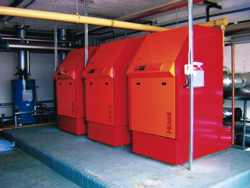Reducing the cost of boiler operation

The capabilities of modern condensing boilers were fully exploited at Braintree college in Essex when three cast-iron sectional boilers were replaced with three Hoval Ultragas downward-firing condensing boilers, each rated at 500 kW. The greater efficiency of the new boilers achieves fuel savings of around 40%. In addition, pipework is simpler and fewer circuit pumps are required.
In comparing the life-cycle costs of boilers, combustion efficiencies are only part of the equation. KEVIN STONES takes an holistic view.While there is no doubt that combustion efficiencies are a vital consideration when specifying boilers, it is important to consider all the other factors that influence life-cycle costs. These range from capital expenditure through installation and commissioning to the day-to-day energy consumption and ongoing maintenance. Some of these life cycle issues are easy to overlook. For example, as well as the fuel used by the burners, heating plant may also consume large quantities of electricity to pump water around the system. Contrary to what one might expect, low-water-content boilers often have higher system pumping requirements than those containing more water. This is because they require a minimum flow rate to be maintained and their narrow waterways increase resistance to water flow — so a shunt pump is generally required to maintain the required flow rates. On the face of it, the life-cycle cost of an additional pump may not seem significant, other than the initial capital and ongoing maintenance costs. On a recent PFI health project, however, the consulting engineers compared the electrical costs of non-condensing boilers requiring a primary header pump and two secondary-circuit pumps with condensing boilers just requiring two circuit pumps. The projected savings were around £56 000 per annum — just on pump electrical costs. The extra capital cost of condensing boilers for this project was £120 000, but when electrical savings are combined with the efficiencies of condensing, this arrangement provides a rapid payback.
All the difference Another factor affecting pumping costs is the temperature difference (∆T) between the flow and return water. Modern boilers can operate with a ∆T of 20 K yet many engineers still design for 11 K, which used to be the UK norm. The significance of the greater ∆T is illustrated by considering a theoretical system. With a ∆T of 20 K the boiler operates with a hydraulic resistance of 8.3 mBar and a flow rate of 41 m3/h. The same system with a ∆T of 11° K has a boiler hydraulic resistance of 28 mBar and a flow rate of 74 m3/h. Clearly, when replacing the boilers in an existing system, changing the ∆T may not be practical because the heat emitters would also have to be resized. For new-build and major refurbishment projects, however, it makes sense to design for 20 K ∆T. This principle applies to both condensing and non-condensing boilers but it is important to bear in mind that steel-shell non-condensing boilers require a minimum return temperature of 55°C to prevent condensation. This may necessitate the introduction of an extra 3-port valve or a shunt pump. In contrast, for condensing boilers the lower the return temperature, the greater the efficiency as more heat is extracted from flue gases by condensation. This has the added bonus of enabling the use of single-skin flues as flue gas temperatures are lower — thus reducing capital costs.
Staying in control Now that the Building Regulations require higher levels of control of heating plant, it is important to pay close attention to the control strategy. To optimise performance of heating plant, it is essential to minimise on/off switching of the boilers by modulating burner operation in response to heating demands. Failure to do so increases energy consumption as the boiler re-warms each time it is switched on, and gaseous emissions are greatest at start up. Where more than one boiler is in use, these principles have to be applied to the sequencing of all of them to minimise the switching of each one. When considering traditional boilers with pressure-jet burners such control can be a key factor, because most burners offer a turndown of only 3:1. In contrast, some condensing boilers offer a turndown of 6:1 (or 12:1 on twin boilers) enabling stop/start operation to be minimised. Another factor to consider for larger boilers with 3-phase pressure jet burners is the need for a gas booster, which increases capital and maintenance costs, especially if a standby booster is required for security. It also increases the amount of control cabling and commissioning. Pressure-jet burners and gas boosters may also require the extra expense of acoustic shrouds. In all cases, commissioning can make a big difference to running costs, and it is important that the commissioning engineer understands both the boilers and the burners. If the boiler manufacturer sub-contracts commissioning work, the quality of the commissioning can vary considerably and have ongoing ramifications for the life-cycle costs of the plant. Finally, ongoing maintenance is another life cost to consider. Boilers that are designed to be easy and quick to maintain and share common parts between different sizes of boiler, so that fewer spares are required, will help minimise these costs.
Kevin Stones is technical director with Hoval Ltd, Northgate, Newark, Notts NG24 1JN.
Related links:









